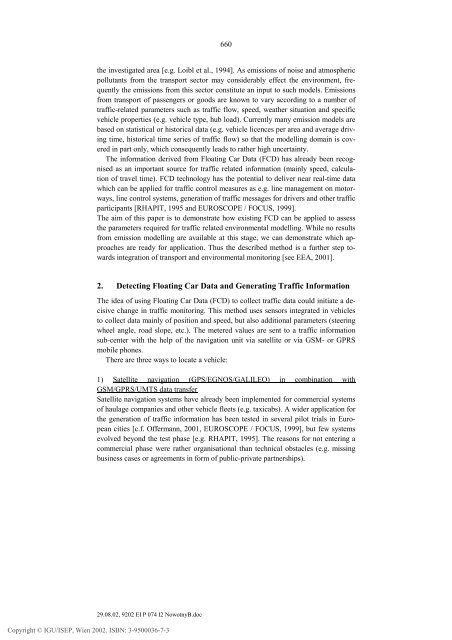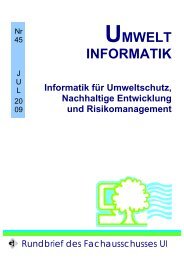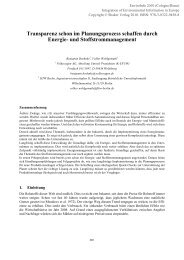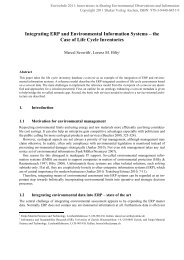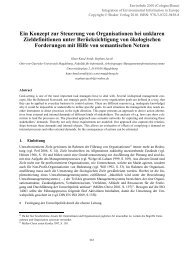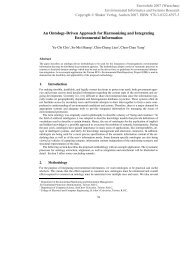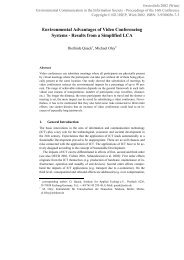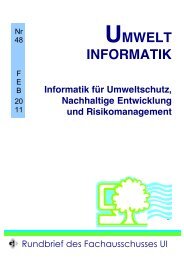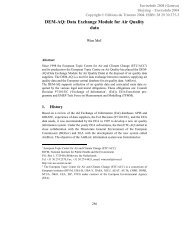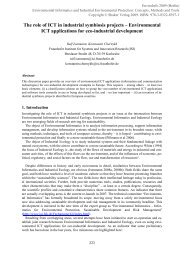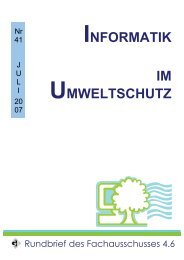Floating Car Data as Data Source for Modelling of Air ... - EnviroInfo
Floating Car Data as Data Source for Modelling of Air ... - EnviroInfo
Floating Car Data as Data Source for Modelling of Air ... - EnviroInfo
You also want an ePaper? Increase the reach of your titles
YUMPU automatically turns print PDFs into web optimized ePapers that Google loves.
660<br />
the investigated area [e.g. Loibl et al., 1994]. As emissions <strong>of</strong> noise and atmospheric<br />
pollutants from the transport sector may considerably effect the environment, frequently<br />
the emissions from this sector constitute an input to such models. Emissions<br />
from transport <strong>of</strong> p<strong>as</strong>sengers or goods are known to vary according to a number <strong>of</strong><br />
traffic-related parameters such <strong>as</strong> traffic flow, speed, weather situation and specific<br />
vehicle properties (e.g. vehicle type, hub load). Currently many emission models are<br />
b<strong>as</strong>ed on statistical or historical data (e.g. vehicle licences per area and average driving<br />
time, historical time series <strong>of</strong> traffic flow) so that the modelling domain is covered<br />
in part only, which consequently leads to rather high uncertainty.<br />
The in<strong>for</strong>mation derived from <strong>Floating</strong> <strong>Car</strong> <strong>Data</strong> (FCD) h<strong>as</strong> already been recognised<br />
<strong>as</strong> an important source <strong>for</strong> traffic related in<strong>for</strong>mation (mainly speed, calculation<br />
<strong>of</strong> travel time). FCD technology h<strong>as</strong> the potential to deliver near real-time data<br />
which can be applied <strong>for</strong> traffic control me<strong>as</strong>ures <strong>as</strong> e.g. line management on motorways,<br />
line control systems, generation <strong>of</strong> traffic messages <strong>for</strong> drivers and other traffic<br />
participants [RHAPIT, 1995 and EUROSCOPE / FOCUS, 1999].<br />
The aim <strong>of</strong> this paper is to demonstrate how existing FCD can be applied to <strong>as</strong>sess<br />
the parameters required <strong>for</strong> traffic related environmental modelling. While no results<br />
from emission modelling are available at this stage, we can demonstrate which approaches<br />
are ready <strong>for</strong> application. Thus the described method is a further step towards<br />
integration <strong>of</strong> transport and environmental monitoring [see EEA, 2001].<br />
2. Detecting <strong>Floating</strong> <strong>Car</strong> <strong>Data</strong> and Generating Traffic In<strong>for</strong>mation<br />
The idea <strong>of</strong> using <strong>Floating</strong> <strong>Car</strong> <strong>Data</strong> (FCD) to collect traffic data could initiate a decisive<br />
change in traffic monitoring. This method uses sensors integrated in vehicles<br />
to collect data mainly <strong>of</strong> position and speed, but also additional parameters (steering<br />
wheel angle, road slope, etc.). The metered values are sent to a traffic in<strong>for</strong>mation<br />
sub-center with the help <strong>of</strong> the navigation unit via satellite or via GSM- or GPRS<br />
mobile phones.<br />
There are three ways to locate a vehicle:<br />
1) Satellite navigation (GPS/EGNOS/GALILEO) in combination with<br />
GSM/GPRS/UMTS data transfer<br />
Satellite navigation systems have already been implemented <strong>for</strong> commercial systems<br />
<strong>of</strong> haulage companies and other vehicle fleets (e.g. taxicabs). A wider application <strong>for</strong><br />
the generation <strong>of</strong> traffic in<strong>for</strong>mation h<strong>as</strong> been tested in several pilot trials in European<br />
cities [c.f. Offermann, 2001, EUROSCOPE / FOCUS, 1999], but few systems<br />
evolved beyond the test ph<strong>as</strong>e [e.g. RHAPIT, 1995]. The re<strong>as</strong>ons <strong>for</strong> not entering a<br />
commercial ph<strong>as</strong>e were rather organisational than technical obstacles (e.g. missing<br />
business c<strong>as</strong>es or agreements in <strong>for</strong>m <strong>of</strong> public-private partnerships).<br />
29.08.02, 9202 EI P 074 I2 NowotnyB.doc<br />
Copyright © IGU/ISEP, Wien 2002. ISBN: 3-9500036-7-3


